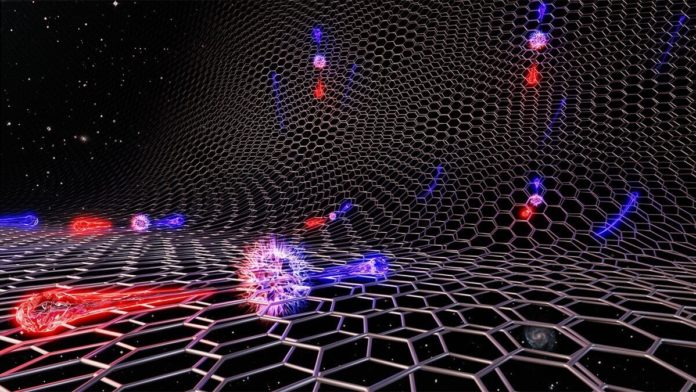The Schwinger effect is the non-perturbative production of electron-positron pairs when an external electric field is applied to the quantum electrodynamical (QED) vacuum.
Recently, scientists from the University of Manchester have successfully observed the effect. By applying high currents through specially designed graphene-based devices, they could produce particle-antiparticle pairs from a vacuum.
Almost 70 years ago, Nobel laureate Julian Schwinger predicted that intense electric or magnetic fields could break down the vacuum and spontaneously create elementary particles. This effect, called the Schwinger effect, is an elusive process that normally occurs only in cosmic events.
Particle physicists, for long, are keen to probe these theoretical predictions experimentally. An international, Manchester-led research team now uses graphene to mimic the Schwinger production of an electron and positron pairs.
For this study, scientists designed narrow constrictions and superlattices using graphene. This allowed scientists to obtain powerful electric fields in a simple table-top setup. This process generated electron and hole pairs that scientists observed clearly, and the process’s details agreed well with theoretical predictions.
The scientists also observed another unusual high-energy process that has no analogies in particle physics and astrophysics. They filled their simulated vacuum with electrons and accelerated them to the maximum velocity allowed by graphene’s vacuum, which is 1/300 of the speed of light.
They observed something that is believed to be impossible: electrons seemed to become superluminous, providing an electric current higher than allowed by general rules of quantum condensed matter physics.
The origin of this effect was explained as the spontaneous generation of additional charge carriers (holes).
The paper’s first author Dr. Alexey Berduygin, a post-doctoral researcher in The University of Manchester’s Department of Physics and Astronomy, said, “People usually study electronic properties using small electric fields that allow easier analysis and theoretical description. We decided to push the strength of electric fields as much as possible using different experimental tricks not to burn our devices.”
Co-lead author from the same department, Dr. Na Xin, added: “We just wondered what could happen at this extreme. To our surprise, it was the Schwinger effect rather than smoke coming out of our setup.”
Another leading contributor, Dr. Roshan Krishna Kumar from the Institute of Photonic Sciences in Barcelona, said: “When we first saw the spectacular characteristics of our superlattice devices, we thought ‘wow … it could be some sort of new superconductivity‘. Although the response closely resembles those routinely observed in superconductors, we soon found that the puzzling behavior was not superconductivity but rather something in the domain of astrophysics and particle physics. It is curious to see such parallels between distant disciplines.”
Journal Reference:
- Alexey I. Berdyugin et al. Out-of-equilibrium criticalities in graphene superlattices. DOI: 10.1126/science.abi8627
